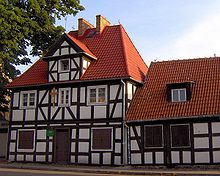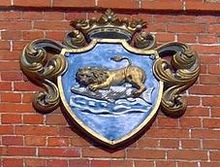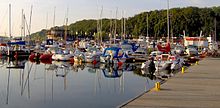Puck (Poland)
| puck | ||
|---|---|---|

|
|
|
| Basic data | ||
| State : | Poland | |
| Voivodeship : | Pomerania | |
| Powiat : | puck | |
| Area : | 4.90 km² | |
| Geographic location : | 54 ° 42 ′ N , 18 ° 24 ′ E | |
| Residents : | 11,213 (Jun. 30, 2019) |
|
| Postal code : | 84-100 | |
| Telephone code : | (+48) 58 | |
| License plate : | GPU | |
| Economy and Transport | ||
| Street : | Władysławowo - Gdansk | |
| Rail route : | Reda – Hel railway line | |
| Next international airport : | Danzig | |
| Gmina | ||
| Gminatype: | Borough | |
| Surface: | 4.90 km² | |
| Residents: | 11,213 (Jun. 30, 2019) |
|
| Population density : | 2288 inhabitants / km² | |
| Community number ( GUS ): | 2211031 | |
| Administration (as of 2015) | ||
| Mayor : | Hanna Pruchniewska | |
| Address: | ul. 1 Maja 13 84-100 puck |
|
| Website : | www.miasto.puck.pl | |
Puck [ puʦk ] ( German Putzig , Kashubian Pùck ) is a port and district town in the Polish Pomeranian Voivodeship . The city has about 11,200 inhabitants and is the seat of the independent rural community of Puck , but does not belong to it.
Geographical location
Puck is located in the former West Prussia , on the Zatoka Pucka (Putziger Wiek) , a shallow part of the Gdansk Bay , about 45 kilometers north-north-west of Gdansk .
history

According to Johann Friedrich Goldbeck , the village was first created by the Pomeranian prince Bugislaus († 1150), who gave it the name Bugustin and called the bay of the Baltic Sea bordering it, the later Putziger Wiek , Buguswick . The place came in 1308 together with Dantzike to the western German order state of Prussia . The town received city rights in 1348 from the Teutonic Order , who called it Bautzig . The town was later also called Pautzke , which eventually became Putzig . Together with other places, especially in western Order Prussia , the city joined the Prussian Confederation , which on February 10, 1454, on the occasion of the marriage of the Emperor's daughter Elisabeth von Habsburg to the Jagiellonian Casimir IV , renounced the Teutonic Order and voluntarily the autonomous, under the patronage the crown of Poland standing Prussia Royal Share , also called 'Polish Prussia', joined. In Royal Prussia Putzig belonged to the Pomeranian Voivodeship .
When the Thirteen-Year Prussian City War broke out in 1454 , Putzig formally placed himself under the protection of the city of Danzig. The fish master's office, which the Teutonic Order operated in Putzig, was administered by the order official Heinrich Reffle von Richtenberg during the war . With the Second Peace of Thorne in 1466, Putzig became the seat of the royal starost . Until 1544, the Putzig area had been in the possession of the city of Gdansk for a period of time, but after the Polish king had paid it a settlement of 6,000 Hungarian and 2,000 Prussian guilders . Since the city of Danzig did not allow any ships chartered for the Polish king in the Danzig area, they had to anchor in the small fishing port of Pautzke on the Pautzker Wiek in 1567.
The Prussian cities that had joined the autonomous Prussian Royal Share were subsequently exposed to attempts at polonization aimed at converting the German-populated area into a Polish province. By his decree of March 16, 1569 on the Lublin Sejm , King Sigismund II August unilaterally terminated the autonomy of West Prussia under threat of severe penalties, which is why the sovereignty of the Polish king in this part of the former territory of the Teutonic Order from 1569 to 1772 was perceived as foreign rule has been.
In 1626 the city was conquered by Sweden, taken by Poland in 1627, and finally again occupied by the Swedes in 1703.
As part of the first partition of Poland in 1772, the area around Putzig and Neustadt came under Frederick II of Prussia to the Kingdom of Prussia . Around 1785 the city had a small Protestant school and was one of the four cities of the Dirschauer district, later to the Neustadt district in West Prussia ; of the 107 fireplaces that the city contained, only 58 were built on at this time.
From 1878 Putzig was the district town of the district of the same name . Around 1835 Putzig had a Catholic church, a Protestant church and a synagogue. In 1898 the city received a train station on the Reda line , which was later extended northwards towards Krokowa and the Hel Peninsula .
In 1913 the first naval aviators of the Imperial Navy were stationed in Putzig . Before 1920 Putzig belonged to the Putzig district in the Danzig administrative district of the West Prussia province of the German Empire .
After the end of the First World War , Putzig had to be ceded to Poland due to the provisions of the Versailles Treaty for the purpose of establishing the Polish Corridor , with effect from January 20, 1920 and without a referendum. Here the Polish General Józef Haller von Hallenburg performed the ceremony of the “ marriage of Poland to the sea ” on February 10, 1920 . The day has been celebrated annually since then.
In the new Pomeranian Voivodeship , Putzig was the district town of Powiat Pucki , before it became part of Powiat Morski (Lake District) on January 1, 1927 . In the interwar period, Putzig was the headquarters of the Polish Navy, founded in 1918, and the only Polish Baltic port, before Gdynia was expanded into a major commercial and military port in the 1920s . In 1934, the Polish state government unilaterally terminated the minority protection treaty concluded in Versailles on June 28, 1919 between the Allied and Associated Main Powers and Poland .
After the attack on Poland in 1939, the district was annexed by the German Reich in violation of international law . It was assigned to the Reichsgau Danzig-West Prussia , to which the city of Putzig belonged until 1945.
Towards the end of the Second World War , the Red Army occupied the region in the spring of 1945 , making it part of Poland again. The immigration of Polish civilians began in Putzig. In the period that followed the German inhabitants were from Puck sold .
The city is one of the strongholds of the Kashubian culture .
Demographics
| year | population | Remarks |
|---|---|---|
| 1802 | 1008 | |
| 1810 | 1018 | |
| 1816 | 1060 | 325 Evangelicals, 601 Catholics and 134 Jews |
| 1821 | 1630 | |
| 1827 | 1818 | |
| 1831 | 1939 | partly Catholics, partly Evangelicals, also Jews |
| 1864 | 2361 | |
| 1871 | 2062 | in 157 residential buildings |
| 1875 | 2095 | |
| 1880 | 2019 | |
| 1890 | 1869 | including 452 Protestants and 62 Jews (700 Poles) |
| 1905 | 2160 | 1628 of them were Germans (75%) and 346 Kashubians (16%), of which 1531 were Catholics, 587 Protestants and 41 Jews |
| 1910 | 2534 | on December 1st |
| year | Residents | Remarks |
|---|---|---|
| 2012 | 11,545 | As of June 30, 2012 |
| 2019 | 11,213 | in June |
Town twinning
-
 Konz - Since March 6, 2001 there has been a partnership between the districts of Puck and Trier-Saarburg , from which the town partnership between Putzig and the German city emerged on November 14, 2003 .
Konz - Since March 6, 2001 there has been a partnership between the districts of Puck and Trier-Saarburg , from which the town partnership between Putzig and the German city emerged on November 14, 2003 .
Other partner cities are:
politics
City arms
The unusual city coat of arms of Puck shows a golden lion gnawing on a silver salmon in blue . According to a legend, the old coat of arms only showed the silver fish in blue, the lion is said to have been added to the city arms of King Charles VIII (Sweden) ( Karl Knutsson Bonde ), who held the city as a pledge between 1457 and 1460 , and comes from the lion of the Goths ( Göta lejon ) in the great national coat of arms of Sweden . There is also an old Kashubian legend about the history of the coat of arms : a salmon and an eel fought for supremacy in the Baltic Sea. Tired and exhausted, intertwined, they were close to death. Suddenly a boat with a lion on it approached them. The lion took the eel into his boat while the freed salmon swam to Putziger Hafen. When he reached Putzig, the lion took the salmon in his mouth and carried it up to the top of the town hall. Since then, both animals have been inseparably united in the city's coat of arms.
Ordensburg Putzig
Putzig Castle was built by the Teutonic Order around 1400. It initially served as the administrative headquarters of the so-called "fish masters" of the Teutonic Order and was subordinate to the Danzig Commandery . The central building of the castle was a residential building made of fire bricks with a stair tower. Since the Duchy of Pomerania returned to Poland in 1454, the castle served as the seat of Polish district administrators until 1795. The castle was expanded in the second half of the 16th century under the district administrators Kostek and Wejher. houses, granaries, a brewery, stables and an armory were built. In 1634 Friedrich Getkant designed a new fortification around the castle and town on behalf of the Polish King Wladyslaw IV . The construction of these new fortifications was only partially carried out due to lack of funds. At the beginning of the 19th century, the Prussian authorities had the castle ruins demolished and a Protestant church built in its place. This church was destroyed and demolished in 1958. In the meantime excavations have taken place on the grounds of the castle. Foundations were found. Remains of a bathing pool of the castle complex that can be heated by a stove are remarkable.
Attractions
- Town hall, built in 1865
- Museum of the Putziger Land
- Parish Church of St. Peter and Paul
- Town houses on the main market square ( pl.Wolności )
- Newly laid out marina
Puck rural community
Puck is the seat of a rural community of the same name, but is not itself part of it. The rural community that includes the city has an area of 243.3 km² on which 26,522 people live (June 30, 2019).
Personalities
- Reinhard Dahms (1944–1966), fatality on the inner-German border
- Heinrich Joseph Horwitz (1824–1899), politician
- Heinrich Rickert (1833–1902), member of the Reichstag and journalist
- Emil Waschinski (1872–1971), historian, numismatist and teacher
literature
in the order of the year of publication
- Johann Friedrich Goldbeck : Complete topography of the Kingdom of Prussia. Part II: Topography of West Prussia. Marienwerder 1789, pp. 52–53, no. 3.)
- August Eduard Preuss: Prussian country and folklore. Königsberg 1835, p. 412, no.28.
- Hans Prutz : History of the Neustadt district in West Prussia . Danzig 1872 ( e-copy ).
- Franz Schultz : History of the districts Neustadt and Putzig. 1907.
Web links
- City of Putzig, Kr.Neustadt (Western Pr.) (Rolf Jehke, 2005)
- City website
- Blackie & Sons Atlas 1882 , Edinburgh: Map Putzig in West Prussia
See also
Footnotes
- ↑ a b population. Size and Structure by Territorial Division. As of June 30, 2019. Główny Urząd Statystyczny (GUS) (PDF files; 0.99 MiB), accessed December 24, 2019 .
- ^ Website of the city, Władze miasta ( Memento of the original from February 23, 2015 in the Internet Archive ) Info: The archive link was inserted automatically and has not yet been checked. Please check the original and archive link according to the instructions and then remove this notice. , accessed February 23, 2015
- ^ A b c Johann Friedrich Goldbeck : Complete topography of the Kingdom of Prussia. Part II: Topography of West Prussia. Marienwerder 1789, pp. 52–53, no. 3.)
- ^ Hans Prutz : History of the Neustadt district in West Prussia . Danzig 1872, p. 69 .
- ↑ Friedrich August Voßberg : History of the Prussian coins and seals from the earliest times to the end of the rule of the Teutonic Order . Berlin 1843, p. 178 .
- ^ Daniel Gralath: Attempting a History of the City of Danzig . Volume 2, Danzig 1790, pp. 70-76.
- ^ Justus Gotthart Rabener: German Acta eruditorum. Volume 85, Leipzig 1723, pp. 709 ff.
- ^ Hans Prutz: History of the Neustadt district in West Prussia . Danzig 1872, pp. 87-88 .
- ^ Hans Prutz: History of the Neustadt district in West Prussia . Danzig 1872, p. 104 .
- ^ A. Reusch: West Prussia under Polish scepter. Ceremonial speech given at the Elbinger Gymnasium on 13th Spt. 1872 . In: Altpreußieche Monatsschrift , NF, Volume 10, Königsberg 1873, pp. 140–154, especially p. 146 .
- ^ Hans Prutz : History of the Neustadt district in West Prussia . Danzig 1872, p. 104 ff .
- ↑ a b August Eduard Preuss: Prussian country and folklore . Königsberg 1835, p. 412, no.28.
- ↑ "Naval aviators: When Wilhelm II ordered his fleet to fly" Die Welt , May 6, 2013
- ↑ a b c d Alexander August Mützell and Leopold Krug : New topographical-statistical-geographical dictionary of the Prussian state . Volume 5: T – Z , Halle 1823, pp. 354–355, item 559.
- ^ Hans Prutz : History of the Neustadt district in West Prussia , Danzig 1872, p. 171 .
- ^ Prussian Ministry of Finance: The results of the property and building tax assessment in the administrative district of Danzig . Berlin 1867, 7th Neustadt district , p. 18, no. 140 .
- ^ Hans Prutz : History of the Neustadt district in West Prussia . Danzig 1872, p. 228, no.153 .
- ^ A b c Michael Rademacher: German administrative history from the unification of the empire in 1871 to the reunification in 1990. Province of West Prussia, district of Putzig. (Online material for the dissertation, Osnabrück 2006).
- ↑ Community encyclopedia for the province of West Prussia: based on the materials from the census of December 1, 1905 and other official sources (Berlin 1908), pp. 100-101 f.
- ↑ gemeindeververzeichnis.de
- ↑ http://www.stat.gov.pl/cps/rde/xbcr/gus/l_ludnosc_stan_struktura_30062012.pdf








